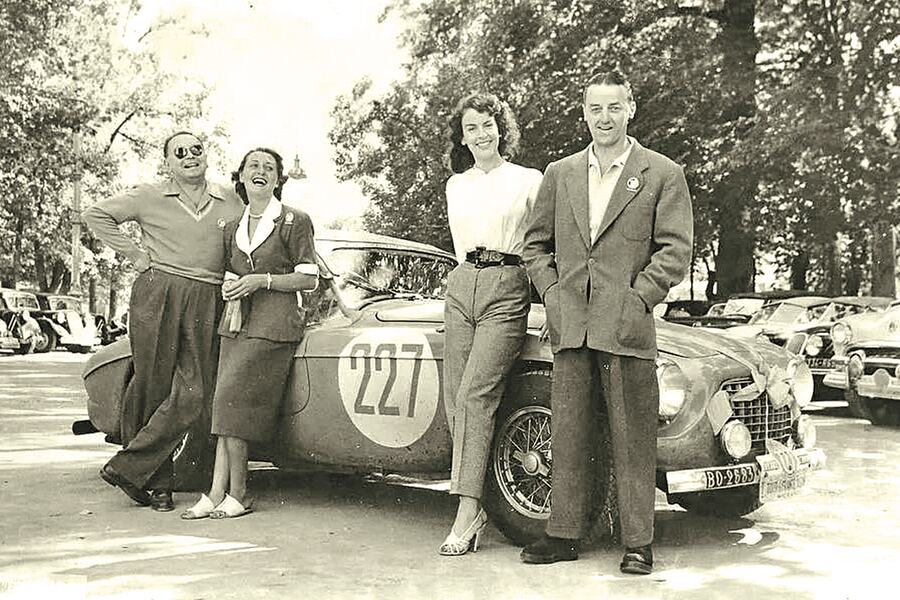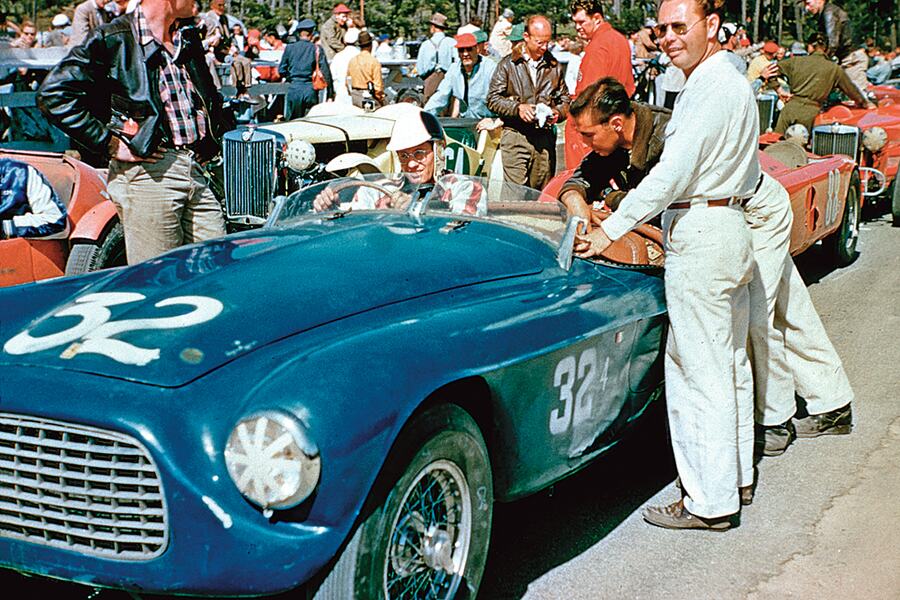After winning the 1948 Mille Miglia with a 166 S, the following year Ferrari introduced an updated model: the 166 MM. While more powerful and built on a shorter wheelbase than its predecessor, the new roadster was best known for its all-new bodywork, crafted by Carrozzeria Touring. The shape was quickly dubbed “barchetta,” or “little boat,” by the Italian press, and so these cars have been known ever since.
In 1949, Ferrari’s 2-liter Barchettas impressed in European sports car racing, winning the Mille Miglia, Le Mans, and the 24 Hours of Spa. The following year, a Barchetta with a larger 195 engine won the Mille Miglia again. For 1951, the 195 was replaced by the 212, and the Barchetta lived on—this time in the form of the 212 Export, one of which, s/n 0078E, is seen here.
S/n 0078’s competition record began at the 24 Hours of Le Mans on June 23-24, 1951. Then painted white and wearing race #30, it was piloted by first owner Jacques La Riviere and co-driver Andre de Guetti. La Riviere took the start, but on Lap 5, while entering the Tertre Rouge turn leading onto the long back Mulsanne Straight, he lost control of his mount and struck a barbed wire fence. Tragically, he was decapitated and killed—not a great start for our featured Ferrari.

Next up for s/n 0078 was the first postwar running of the Tour de France Auto, from August 30 to September 12. Now painted medium French blue, equipped with a full windshield and folding top, and wearing race #227, the 212 was driven by Pierre “Pagnibon” Boncompagni and Alfred Barraquet. Unlike La Riviere, Pagnibon not only finished the 14-day race/rally, he crossed the line in first overall.
After the Tour de France, American Ferrari importer Luigi Chinetti entered the picture. Under his direction, the Barchetta was returned to the factory, where the original single twin-choke Weber carburetor was replaced by three twin-choke carbs—in other words, updated from touring specification to full-race—raising output from 150 hp to 170 hp or more. It was in this form that Chinetti arranged for the sale of s/n 0078 to a promising young American racer named Phil Hill. It would be Hill’s first, but far from his last, Ferrari.
Prior to acquiring the Ferrari, however, Hill had entered into a gentleman’s agreement with Jaguar importer Charles Hornburg to race Hornburg’s Jaguar XK-120 LT-3, one of three lightweight roadsters specially built as a hedge against the C-Type that would follow in 1952 and ’53. It was a dilemma, but as Hill later put it, “You were either worth your personal word or were not.” So he stuck to his agreement with Hornburg and drove the LT-3, turning over the 212 Barchetta to close friend Arnold Stubbs.

“Pagnibon” (far left) and Alfred Barraquet drove the Barchetta in the Tour Auto.
On April 20, 1952, Stubbs entered s/n 0078, still painted medium French blue and now wearing race #32, in the third-annual Pebble Beach Road Races feature: the Del Monte Trophy sprint. After 100 miles on the six-turn, 2.1-mile circuit, the Barchetta placed second behind Bill Pollack in Tom Carsten’s Cadillac-Allard J2. Meanwhile, Hill finished a distant fifth in the overheating Jaguar LT-3. The closest he came to s/n 0078 was in the pits, where the Jag and the Ferrari sat in adjoining boxes.
After Pebble, Hill decided to repaint the Barchetta a proper Ferrari red. He then entered the car in the first running of the Golden Gate Park Races in San Francisco, held May 30-31 on a 3.1-mile, eight-turn circuit. The feature Guardsman’s Cup was an 86.8-mile sprint race contested by numerous American V8-powered Allards, XK-120 Jags, and assorted specials (including two of Sterling Edward’s), all driven by talented racers. The major protagonist was once again Bill Pollack in Carsten’s Cadillac-Allard J2, which had won the last three Over 1500-cc feature races on the West Coast.
The starting grid was set by displacement, with Pollack’s 6-liter Allard on pole and Hill’s 2.6-liter Ferrari, wearing #22, back in 16th. When the starter’s flag dropped, the 275-hp Allard out-accelerated the smaller displacement cars into the first turn. Hill, being cautious not to burn up his clutch, made a smooth start, then began to pick off the less agile big-bore cars one by one. By Lap 3 of the 28-lap race, the Ferrari had climbed to second place behind the Allard.

Arnold Stubbs (in car) debuted the Ferrari in the United States, at the Pebble Beach Road Races.
By pushing Pollack into the turns, Hill kept the pressure on the leader, who soon had to begin to conserve his overworked brakes. As the final lap began, the Ferrari was right on the Allard’s tail—but all of sudden, the Italian V12 began to run on six cylinders. One of the dual ignition coils had broken loose from the firewall, and was later found tangled by the steering. Hill limped to the checkered flag with a very rough sounding engine, finishing second behind Pollack. It was a great disappointment for Hill, who had to settle for a Class D/4, rather than outright, win.
NEXT UP ON HILL’S COMPETITION CALENDAR was the second running of the races at Torrey Pines, a former Army base just north of San Diego, on July 20. The 2.7-mile circuit was located between the Pacific Coast Highway and the Pacific Ocean, in a hilly section which later became a championship golf course. Although the Pebble Beach and Golden Gate Park races were sponsored by the Sports Car Club of America, Torrey Pines was hosted by the California Sports Car Club (a.k.a. Cal Club), a rival Los Angeles-based race organization made up of serious drivers and machinery.
Competition in the feature Over 1500-cc race came from Bill Pollack in Tony Parravano’s 4.1-liter 340 Vignale Coupe, Hill’s brother-in-law Don Parkinson in his lightweight Jaguar special, Chuck Manning in his Mercury special, and Hastings Harcourt driving an Oldsmobile-Allard. The grid was filled out by other Allards with Cadillac and Chrysler V8s and a Chevrolet-powered Nardi.

Phil Hill (at left) inspects 2-liter Ferrari V12.
Following an Under 1500-cc race, in which my close friend Bob Doidge drove his Porsche 356 coupe to victory ahead of Hill in a borrowed MG TD, it was time for the feature race: the 30-lap San Diego Cup. Back behind the wheel of s/n 0078, now wearing race #2, Hill started from the third row and soon took over the lead. He then drove a very consistent race and took the checkered flag after lapping the entire field—what a redemption!
Always attentive to great drivers and their need to excel, Chinetti contacted Hill with a proposal to acquire a new 3-liter 250 MM Vignale Spyder (s/n 0260MM), which would later appear at the 1954 New York Auto Show. Hill approved and decided to sell s/n 0078, listing it for sale at $7,800 in the January 1953 issue of Road & Track. (The ad had been preceded by a two-page feature article on the car in Road & Track’s November 1952 issue.) The Barchetta was sold in January 1953 to Howard Wheeler, who would race it 14 times in California and Arizona in 1953 and ’54, scoring many class wins and podium finishes along the way.
The Ferrari passed through a few hands over the next three decades before being acquired, in 1986, by Sherman Wolf. Wolf’s collection already included the ex-Sterling Edwards 340 MM which had won the 1954 Del Monte Trophy, a long-wheelbase alloy-bodied California Spyder, and a 500 TRC.

Hill ran this ad in Road & Track when he decided to sell the 212.
Needless to say, Wolf was a serious Ferrari enthusiast, and regularly entered his cars in various national and international rallies and tours. He drove s/n 0078 in the Colorado Grand six times in the 1990s, in the Tour de France Auto three times, and in the Mille Miglia retrospective four times. He was also a friend of Phil Hill, who joined him in the Barchetta at various events, including the 1994 Monterey Historic Races, where Hill drove his old Ferrari to victory.
Wolf regularly encouraged his co-drivers to take s/n 0078’s wheel, and instructed them on how to use the five-speed non-synchromesh gearbox to perfection. Despite then being more than 40 years old, the Barchetta was the opposite of a trailer queen. Wolf passed away in 2012, at age 86, and left a significant mark in the world of collector Ferraris.









